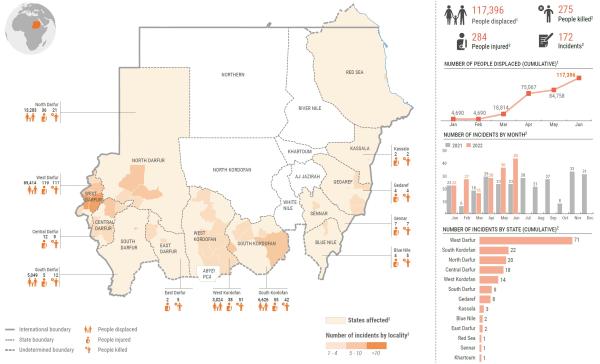Sudan
2022-06 Factsheet - Sudan
Highlights
Shelter and NFI needs in Sudan continue to grow following the deterioration of political and economic situation since the military power takeover late last year. Competition for land and resources continues to be the key driver of displacement as environmental degradation and drought cause shifts in migration patterns, pushing many nomadic groups to transition from pastoralism to the semi-sedentary lifestyle, occupying lands of others in the process. The dire situation is further compounded by the macro fall out of the Ukrainian crisis, driving food insecurity, rising energy prices and inflation across Sudan. With 2,7M people in need highlighted in HNO ’22, as well as 145,782 newly displaced in 2022 as of June 30, the Shelter and NFI Cluster struggles to mount an adequate response with only 6,6% of its HRP requirement funded.
NFI(HH)
Shelter(HH)
Need analysis
According to 2022 Humanitarian Needs Overview (HNO), there are a total of 2.7 million people in need of shelter and NFI assistance. This includes IDPs, refugees and asylum seekers, returnees and vulnerable residents. However, due to deteriorating economic situation and continuous displacement, the shelter and NFI needs continue to grow.
So far, 117,396 people have been internally displaced by intercommunal violence, mainly in West Darfur (76%) while 28,386 refugees and asylum seekers arrived in the country, mostly from South Sudan.
Response
In the first two quarters of 2022, sector partners reached a total of 55,885 households with NFI kits and 15,463 households with emergency shelter kits (ESKs), while 5,595 households received cash/vouchers for emergency shelter assistance and 1,572 households received tents. A total of 115 households received in-kind durable shelter support while 2,856 households received cash/vouchers for transitional/durable shelter assistance. Similarly, 922 households received construction materials for shelter upgrades. A total of 82,408 households received some type of S/NFI assistance across West Darfur (32%), Gedaref (20%), South Darfur (15%), North Darfur (13%), Khartoum (4%), South Kordofan (3%), Khartoum (3%), White Nile (3%), Blue Nile (3%), Red Sea (2%), Central Darfur (1%), East Darfur (1%) and Kassala (1%). The following population groups were targeted: refugees (52%), IDPs (38%), vulnerable residents (7%) and returnees (3%).
Gaps / challenges
With other crisis taking precedence, Shelter and NFI Cluster in Sudan remains only 6.6% funded. Even though it appears 24% of targeted households were reached, it’s important to note that as much as 69% of households reached were not supported with the full/standard assistance package due to funding limitations. There are limited stocks available for responding to new and sudden displacements which is impacting cluster preparedness efforts. Further, there is also limited partner presence in certain states such as Sennar, Al Jazeera, River Nile, Red Sea as well as Abyei PCE, which is affecting cluster’s capacity to respond to emergencies in a timely manner.
Access to some areas, particularly those affected by conflict and flooding during the rainy season, remains a challenge and is limiting clusters ability to conduct assessments, respond to needs and monitor the response. Local natural materials, which are the most cost effective and climate/cultural appropriate emergency shelter solution are not available year-round and are bulky to store. Hence there is a challenge to provide climate suitable shelter materials, especially during the rains. While certainly more environmentally friendly than plastic sheeting, local natural shelter materials do pose a risk to already stressed environments in some states, due to poor harvesting practices. HLP issues which are the key driver of conflict in Sudan, pose the biggest impediment to pursuing more sustainable and durable shelter solutions for IDPs.

